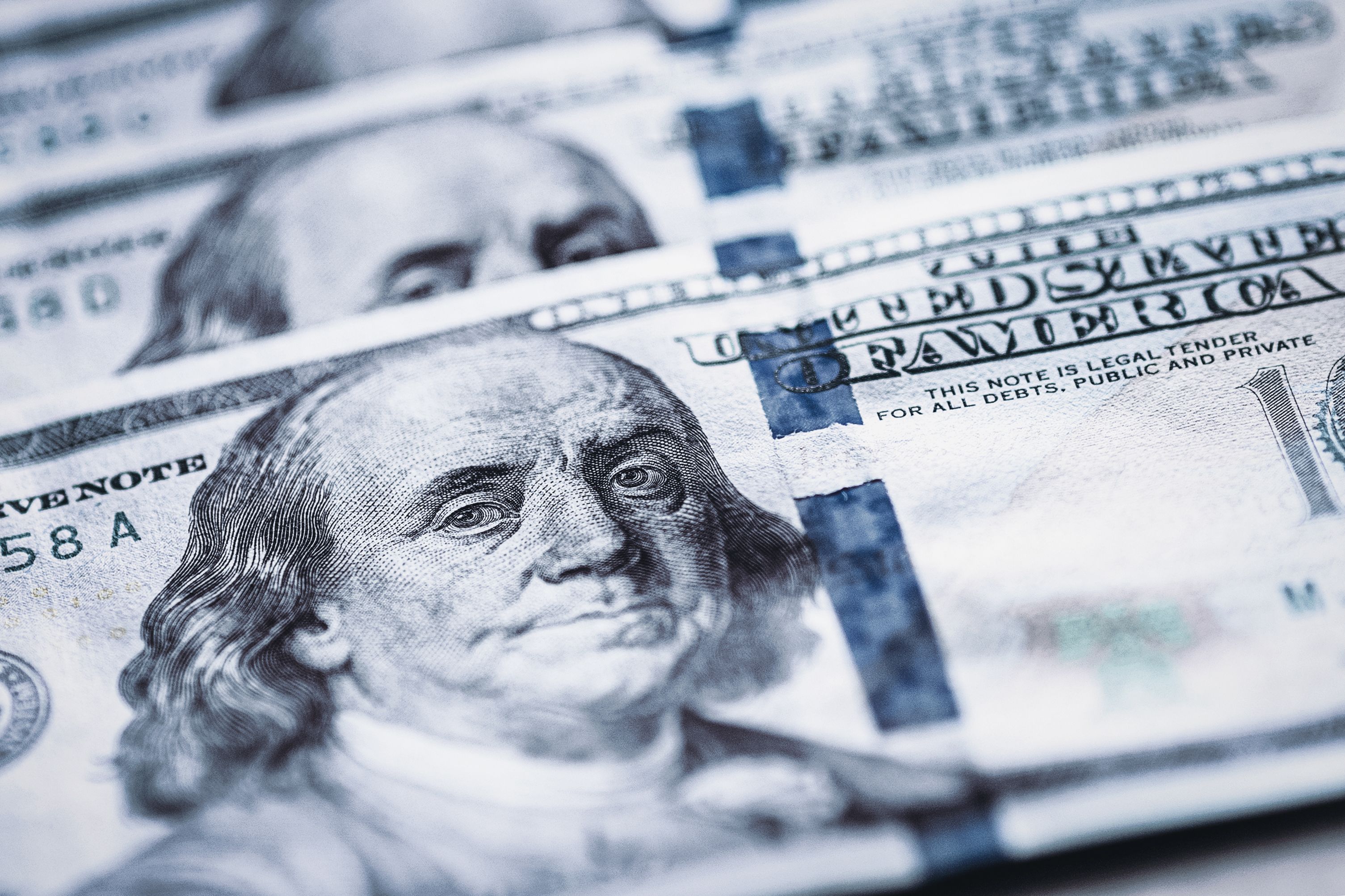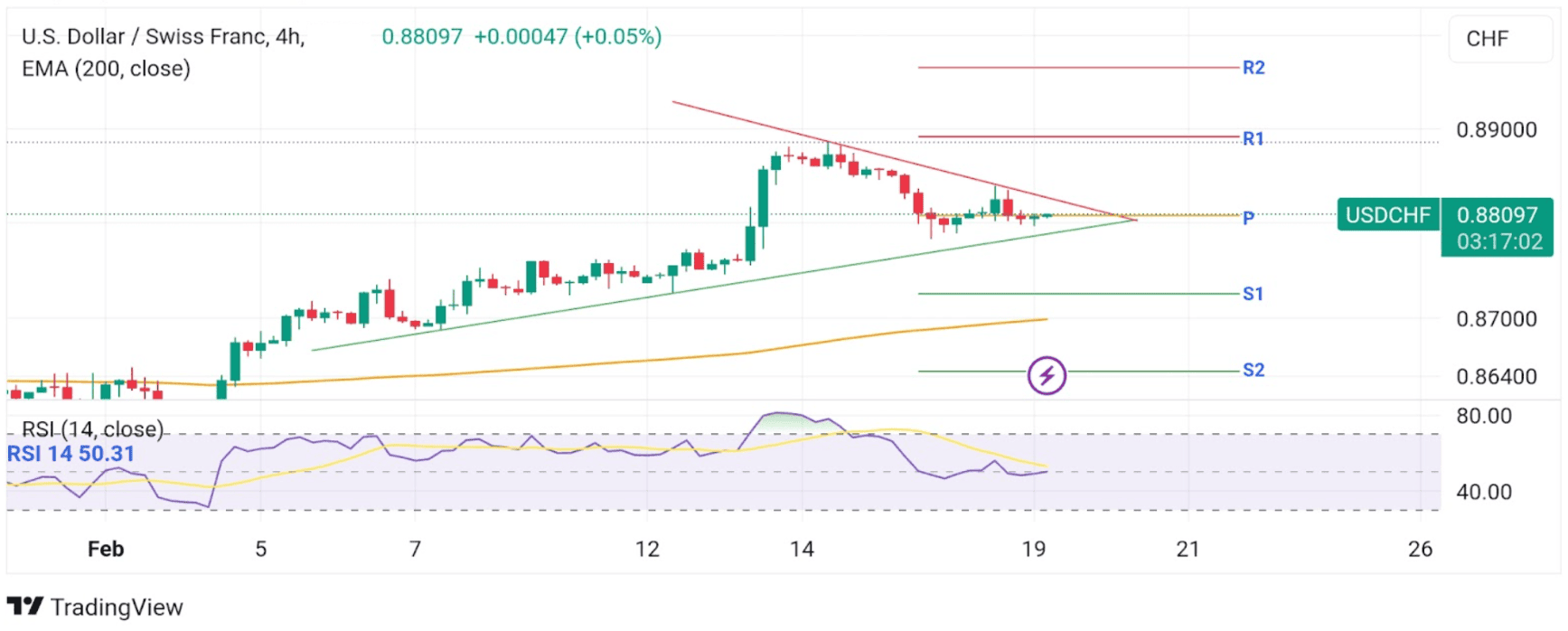USD/CHF Retakes 0.88000's On Hawkish Fed Expectations, U.S. Markets Closed For Washington's Birthday Holiday






Key Takeaways:
- USD/CHF cross reverses an intraday low amid the emergence of some USD-dip buying on Monday during the Asian session
- Hotter-than-expected U.S. PPI data fully cements market expectations that the Fed will leave rates unchanged during the March meeting
- A combination of downbeat Swiss macro data undermines the Swiss Franc (CHF) and helps exert upward pressure on the USD/CHF pair
- The U.S. markets remain closed today as the U.S. celebrates Washington's Birthday Holiday
USD/CHF pair extended the sharp bounce from the vicinity of the 0.87970 level touched earlier in the session and rose above the 0.88000 mark during the mid-Asian session to kick off a new week on a high note.
A modest resurgence in U.S. dollar demand witnessed earlier today is a key factor that helped limit further losses around the USD/CHF cross. This comes as investors scaled back their bets on the timing of interest rate cuts after a hotter inflation report.
A U.S. Bureau of Labor Statistics (BLS) report released on Friday showed Producer prices for final demand in the U.S. were up 0.3% month-over-month in January 2024, the most significant increase in five months, following a 0.1% decline in December compared to forecasts of 0.1%. The cost of services rose 0.6%, the most significant increase since July, led by a 2.2% increase in hospital outpatient care prices. Year-on-year, producer prices rose 0.9%, slightly less than 1% in December, but above expectations of 0.6%. The core PPI, which excludes food and energy, rose 0.5% on the month, pushing the annual rate higher to 2%, both above forecasts.

The hotter-than-expected wholesale inflation report came days after another U.S. BLS report showed consumer inflation in the U.S. unexpectedly rose in January, which, when combined with the recent robust U.S. job data and recent hawkish Fed comments, thoroughly debunks the idea of early aggressive rate cuts and supports the view that rates are likely to stay higher for longer.
That said, CME's fed watch tool also shows fed fund futures traders have priced in an 89.5% and 64.5% chance the Fed will keep rates unchanged at 5.25% - 5.5% during the March and May meetings, respectively, up from 82.5% and 39.3% chance early last week, with the first-rate cut now seen during the June meeting.
Further underpinning the safe-haven buck was the upbeat University of Michigan report released on Friday, which showed consumer sentiment for the U.S. increased to 79.6 in February 2024 from 79 in January, a fresh high since July 2021, but slightly below market forecasts of 80, preliminary estimates showed. Consumers continued to express confidence that the slowdown in inflation and strength in labor markets would continue. The expectations index improved (78.4 vs 77.1), while the current economic conditions gauge edged down (81.5 vs 81.9).
In other news, Building permits in the United States dropped by 1.5% to a seasonally adjusted annual rate of 1.470 million in January 2024, down from December's 1.493 million and disappointing market projections, which anticipated a rise to 1.509 million, a Census Bureau report showed.
In that same line, housing starts in the U.S. slumped 14.8% month-over-month to an annualized 1.331 million in January 2024, the lowest since August and missing market forecasts of 1.46 million. It is the biggest fall since April 2020, following a revised 3.3% increase to 1.562 million in December.
Shifting to the Swiss docket, a Swiss Federal Statistical Office report released last week showed inflation in Switzerland dropped to a two-year low in January, suggesting the Swiss National Bank (SNB) could start cutting rates as soon as the next monetary policy meeting despite holding rates unchanged at 1.75% during the last two meetings.

The annual inflation rate in Switzerland eased to 1.3% in January 2024 from 1.7% in the previous month, coming less than market forecasts of 1.7%. It marked the lowest reading since October 2021, as inflation for housing and utilities slowed to 2.5% from 3.3% in December, while those for food and non-alcoholic beverages eased to 2.3% compared to 3.3%. Every month, the CPI grew 0.2%, well below market expectations of a 0.6% jump after stagnating in December. Meanwhile, the core rate, which excludes volatile items such as unprocessed food and energy, moderated to 1.2% from a prior 1.5%.
Elsewhere, industrial production in Switzerland fell 0.4% year-on-year in the fourth quarter of 2023, reversing from a downwardly revised 1.8% drop in the previous three-month period, as output tumbled for manufacturing (-1.6% vs 1.1% in Q3).
That said, the downbeat Swiss macrodata, to a greater extent, undermines the Swiss Franc (CHF) and helps exert upward pressure on the USD/CHF pair. However, the ongoing retreat in U.S. Treasury bond yields continues to act as a headwind to the buck. It might help limit further gains around the USD/CHF pair, warranting caution for traders against submitting aggressive bullish bets. Additionally, signs of stability in the U.S. equity markets continue to undermine the buck and might help cap the upside for the USD/CHF pair.
As we advance, the U.S. markets remain closed today as the U.S. celebrates Washington's Birthday Holiday; hence, there will be minimal trading volume. Nevertheless, the general market risk sentiment and Treasury bond yields will continue to influence the U.S. dollar sentiment and provide short-term trading opportunities around the USD/CHF pair.
Technical Outlook: Four-Hour USD/CHF Price Chart

From a technical perspective, USD/CHF is trading with modest gains above the 0.88000 round mark following an extension of the sharp bounce from the vicinity of the 0.87970 level and the subsequent acceptance above the pivot level (P) at 0.88075. Some follow-through buying would face initial resistance at the upper limit of the Bearish Symmetrical Triangle pattern plotted by a downward-sloping trendline extending from the mid-February 2024 swing higher-highs. For further confirmation of the extension of the bullish uptick, buyers would need to find acceptance above this key barrier. Above this level, the following resistance levels can be seen at 0.88916 (R1), followed by 0.89658 (R2), and in highly bullish cases, the 0.90000 psychological mark.
On the flip side, if sellers resurface and spark a bearish turnaround, initial support comes in at 7.20120 (P). Sustained weakness below this level would pave the way for a drop toward the lower limit of the Bearish Symmetrical Triangle pattern plotted by an upward-sloping trendline extending from the mid-February 2024 swing lower lows. A convincing move below this (bearish price breakout) will pave the way for an accelerated drop toward the 0.87258 support level (S1). A clean move below this level will pave the way toward the technically strong 200 Exponential Moving Average (EMA) at the 0.86991 level. A decisive move below this level would act as a fresh trigger for new sellers to jump in, provoking an extended decline toward the 0.86449 level (S2), and in dire cases, the USD/CHF pair could extend a leg down toward the 0.85575 - 0.85505 demand zone.
